Fishing With Live Bait
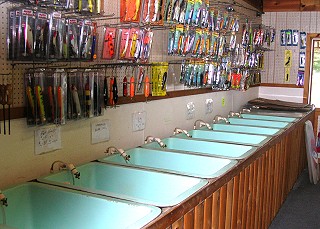 With all of the innovative and high tech features that artificial lures currently have, fishing with live bait still produces over 50% of freshwater game fish caught in North America.
With all of the innovative and high tech features that artificial lures currently have, fishing with live bait still produces over 50% of freshwater game fish caught in North America.
Dependent on the time of the year and water temperatures or when fishing slows down live bait is definitely the preferred choice for a successful catch.
Most live bait are purchased at a local Sport Shop or for a rewarding experience can be caught by yourself. Whether you buy or catch your bait it should always be kept fresh and lively, active fresh minnows, worms and leeches catch fish, it will also save you money by learning how to keep your bait alive.
The following are the most popular live bait used, types of containers and care for inland freshwater fishing.
Fishing with Bait Fish
To most anglers the word minnow means a small fish used for bait. Minnows are apart of a fish family that includes over 250 species in North America. The most commonly used and commercially sold minnows are Fatheads, Chubs, Shiners and Suckers.
Fathead

Fatheads are the most popular and universal of baitfish and are commonly used as forage for game fish. The fathead minnow is a fresh water fish, native to most states. They generally reach 2 to 3 inches in length and have a life span of two to three years. Fathead minnows are sometimes called “tuffy”, “ruby red”, or “blackhead.”
They come in two different colors, black and rosy red (orange). Fatheads feed on small organic organisms, and their maximum length seldom exceed three inches in size thus making them one of the best forage fish available for bass, bluegill, walleye, and crappie to feed on.
Spawning begins when the water temperature reaches 50 to 55 degrees Fahrenheit and repeats monthly until water cools down in the fall. In Northern States, the fathead minnow inhabits boggy, stained colored lakes, ponds and slow moving streams. In Southern states it lives in silt or mud bottomed lakes ponds and slow moving rivers.
Chub (Creek Chub)

Creek chubs are a main forage item for many predators, such as walleyes, brown trout, northern pike, largemouth bass, and smallmouth bass. Because they often school in lakes, loons, kingfishers, and mergansers also commonly eat them. Little creek chubs even have to watch out for bigger creek chubs.
The creek chub is one of the “Big Three” native minnows (the other two are common shiner and hornyhead chub). Males sometimes attain lengths of 10″-12″ and weigh up to 12 oz. Females reach about 7″-8″ weigh up to 8-10 oz. Creek chubs can live for 7-8 years although few make it past 5.
Hornyhead Chub ( Red Tail Chub)

The hornyhead chub, also known as the redtail chub, is olive brown on the back, silvery on the sides, and creamy below. At the base of the tail, which is red, young fish have a distinct spot. This spot becomes less distinct with age. Adult males reach a length of about 6 to 9 inches (females are smaller). Spawning occurs from late May through June. The male constructs a nest carrying small rocks in his mouth to the spawning site.
The finished nest is a small mound of stones 1-3 feet in diameter and a few inches high. The eggs are deposited into a small depression opened by the male in the nest. The hornyhead feeds primarily on insect larvae, but eats other small animals, such as earthworms and crustaceans; some algae is also eaten. It is used as a popular baitfish for walleyes and northern pike.
Common Shiner

Common shiners average about 2 1/2 to 4 inches long; some reach 8 inches. Their color is basically silvery with a dusky back. In comparison with similar species, the head, eyes, and mouth of the common shiner seem noticeably large. Their native range is Midwest and Eastern States. It inhabits both warm and coldwater streams and may be found in the same cooler waters as trout. Common shiners spawn in spring.
Gravel in riffles is often used for spawning, but they commonly spawn over the nest of a creek chub, river chub some males excavate their own small nests. The common shiner feeds at or just below the water surface primarily on insects. Because it is common and readily caught it is important forage fish for many game fish as a popular bait minnow, especially in the Northern States for ice fishing. Also known as Silver Shiner, Redfin Shiner, Creek Shiner, Eastern Shiner.
Golden Shiner

The golden shiner are found throughout the U.S. with the exception of a few upper Western States. Young golden shiners are silvery with a dark band on the side as they mature the band fades developing a golden color with a dark bronze brown back. Golden shiners live in clear, weedy, quiet, shallow sections of lakes, ponds, and occasionally rivers. Both young and adult fish show schooling patterns in shallow depths no greater than 2-3 ft.
Golden shiners spawn over an extended period from May to July. Eggs are released, fertilized and allowed to settle into vegetation while mating fish continue to swim. They have been observed using active nests of largemouth bass to deposit their own eggs. This behavior is quite remarkable since largemouth bass are know to feed heavily on them. Also known as Roach, American Roach and Pond Shiner
Mud Minnow

The upper part of the body is olive-brown in color, mottled throughout, with up to 14 indistinct brown vertical bars on the sides and a prominent dark vertical bar located at the base of the tail. The belly is yellow to white and fins are brownish, large scales, and they can tolerate low oxygen levels.
Central Mudminnows occur in quiet areas of streams, sloughs, swamps and other wetlands over mud and debris and often found in dense vegetation. They tolerate low oxygen levels and extreme water temperatures. Used extensively as a bait minnow where plentiful. Preferred bait for many walleye anglers because of its hardiness. Also known as Mississippi mud minnow, Mudfish and Dogfish.
Suckers

Suckers are found in nearly all types of waters with 80 species native to North America. The most common used for bait is the White Sucker. White suckers are usually about 10-20 inches long and weigh 1-2 pounds, some unusual specimens weighing as much as 8 pounds.
Their color is olive brown, and they have a cylindrical shape. The white sucker is widely distributed through out most of the U.S. water systems. Although the white sucker is found in a wide variety of water conditions, these fish typically inhabit lakes and reservoirs that have tributary streams. White suckers feed on a variety of invertebrates found among stream and lake substrates.
Young white suckers are used as bait for walleyes and northern pike, larger suckers for muskies. The white sucker goes by a number of other names, like common sucker, coarse-scaled sucker, brook sucker, gray sucker, mud sucker, sucker, mullet, black mullet, slender sucker, june sucker and white horse.
Care and Keeping of Baitfish
When fishing with minnows and suckers having fresh lively bait can make a world of difference in getting a bite. The action of a struggling minnow/sucker on a hook with a natural scent will draw attention of nearby fish even enticing neutral or negative mood fish to a reactionary strike.
Here’s a few pointers in keeping your live bait alive long enough to be useful especially during the summer months
1. Keep them Cool…..Nothing kills minnows and suckers quicker than extreme heat.
Keep your bait bucket in the shade and out of direct sunlight. Warm water greatly reduces the oxygen content. Small amounts of ice can be added periodically, but do not overload the ice or the temperature drop will shock the fish and kill them.
2. Changing the Water….. If the water in your bait container turns cloudy because of ammonia being released (waste) by the baitfish or they are at the top gasping for air the water needs to be changed. If you’re on a lake or river make sure you temper the water in the minnow bucket to the same temperature as the water system you’re fishing by adding small amounts of water rather than submerging the entire bucket.
Rapid change in temperature will send the baitfish into shock and they eventually die. In adding or changing water from a city tap use a de-chlorinator to remove the chlorine, a few drops goes a long way. Most bait shops or your local pet store have chlorine removers in a liquid. Water from a well or bottled water requires no de-chlorinator.
Note: (VHS) Viral Hemorrhagic Septicemia is a deadly fish virus and a invasive species that is threatening many game fish in North American water systems. Before fishing with live minnows and suckers, please check your Local Sport Shop / State Department of Natural Resources fishing regulations concerning the use, transport and disposal of baitfish including the use of water from bait containers. Please support and follow all regulations in helping the DNR stop this threat.
3. Proper amount of bait…. Over crowding of minnows or suckers in a bait container will immediately reduce the amount of available oxygen, and increase the toxic ammonia level from their waste. If you over fill your container with minnows by the time you get to your destination from the bait shop probably and 1/3 or more of your bait will be dead floating on the top. Here is a recommended guide line based on minnow sizes and a standard sized minnow bucket at 8 quart capacity.
Small ( Crappie Fathead Minnows) 3/4″- 1″
Standard 8 Qt 6 dozen
Medium ( Fathead’s, Small Chubs & Shiners) 2″-3 1/2″
Standard 8 Qt 4-5 dozen
Large ( Chubs, Suckers & Shiners) 3 1/2″ – and Up
Standard 8 Qt 1-1 1/2 dozen
Large Suckers 10″ -18″
Recommended 5 gallon bucket or larger 2-3 suckers
Rigging Baitfish

There are three basic options to bait a minnow on a hook. The first is in the mouth insert the point of the hook under the lower lip and push the hook through the top lip, the hook shank will be facing forward with the tip of the hook facing up. This allows the baitfish to look natural as it swims forward.
Lip hooked baitfish are used tipped on a jig or live bait rigs; sliding weight bottom rig, bottom bouncers, drop shot rig or on a float/bobber set-up. By hooking the baitfish through the lips will keep the water from circulating into the gills and it will eventually die. Check your bait often. Lip hooked baitfish also work well on preserved baits.
The second option is hooking the baitfish through it’s back in front of the dorsal fin, be careful to pierce only the skin and not through the spine. Using this method the baitfish will keep it alive for a longer time. This hooking technique is used when stationary fishing, a floating/bobber set-up or for ice fishing hooking a baitfish on a tip-up.
The final option is hooking through the tail for free-line fishing. Insert the hook tip at the fleshy base of the tail and run it through, ending with the hook tip and shaft facing rearward. Use a simple split shot and hook rig cast the minnow gently and let it sink and drift while it swims freely.
Fishing Baitfish Containers
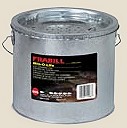 The basic angling tool in keeping and transporting live baitfish to your fishing spot is the minnow bucket. Years back galvanized steel bait buckets were used and are still found in many tackle shops. Today the traditional minnow bucket is still used only made from hard plastic.
The basic angling tool in keeping and transporting live baitfish to your fishing spot is the minnow bucket. Years back galvanized steel bait buckets were used and are still found in many tackle shops. Today the traditional minnow bucket is still used only made from hard plastic.
There are other styles and options available to make your fishing more efficient and convenient. Here’s a quick overview to choosing the right style of bucket for the different ways you may fish.
Standard Two Bucket Design

The traditional lift out bait bucket has a outer hard plastic bucket with a inner liner that fits inside.
The inner bucket has a floating cover with a snap open door the bottom is perforated like a strainer. This lets the angler to select bait from the liner by lifting out of the outer bucket draining the water.
It is also useful when stationary fishing in keeping bait fresh and lively by placing the inner bucket liner in the lake or off a dock as a holding container. Other features now include notches, holes and clips for holding dip nets, air hoses, aerators and pliers.
Trolling Buckets
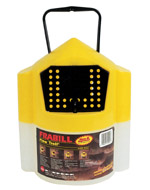
Trolling style buckets are ideal when trolling as they pull easily behind boat or in current when wading. The weighted keel design keeps the bucket from rolling over and positions the self closing bait door floating face up for easy access to your bait. The trolling bucket constantly aerates the bait as it moves through the water.
Plastic Insulated Buckets
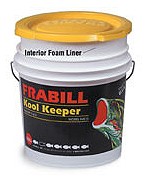
By combining a foam liner and the durability of a molded plastic outer bucket you have the best portable container for baitfish. The inner liner keeps baitfish cool during the warm months it also reduces freezing of water in colder temperatures. For storing baitfish for several days add a battery powered aerator keeping the water oxygenated.
The water should be periodically checked and changed, over time the foam liner should be cleaned from residue build up with a fine grit sandpaper and rinsed with plain water using no soap or cleaners.
Styrofoam Buckets
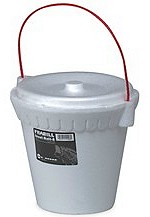
For the seasoned angler we can bet that you have a collection of Styrofoam buckets in your garage or fishing shed. They do come in handy when you need a extra bucket or forgot to bring yours along to the bait shop. Foam buckets do a excellent job of keeping baitfish alive in heat or cold they insulate well and keep the water temperature consistent.
The drawbacks are they are fragile and changing water, with the solid lid design trying to pour out water with baitfish inside can be a tricky in not losing bait. *Tip* For ice fishing foam buckets work very well in keeping the water from freezing but the lid in colder weather tends to freeze to the bucket. To eliminate freezing lids, apply a thin layer of Vaseline around the outer edge of the lid and bucket.
Aerators
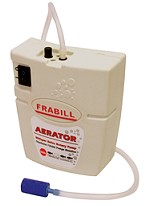
Buying an aerator will quickly pay for itself by reducing the mortality rate of your baitfish along with keeping your bait fresh and lively. Portable aerators use batteries from sizes from AA to D cells and have clips for attaching to bait bucket lids with air hoses and air stones.
Other upgraded options include adapters to hook up to a 12 volt battery, a built in light helpful for low light and night time fishing and low and high output oxygen level adjustment controls. Gentle aeration is the key, smaller bubbles carry more oxygen, you do not want your baitfish churning around your bucket in waves. The other consideration is sound, remember you will be listening to the humming of the pump while fishing, invest in a high quality aerator that markets itself as whisper operation or quiet bubbles, in the long run you will be glad you did.
Anglers that will store baitfish for an extended period of time in a cooler or a baitfish tank should look at buying a plug in aerator rather than replacing batteries. This allows you to keep baitfish alive for days in your garage, porch or fishing cottage. Some tackle companies sells 110 volt air pump systems or you can visit your local pet shop and buy the components; air pump, hose and stone and save money. *Tip* If your using a plug in aerator always keep the pump above the water line so water can’t siphon back if a power failure occurs.
As a pump operates, it will vibrate and move around, secure the pump so it does not fall off into the water, we can attest for this first hand, pump failure will result in a bucket of dead minnows.
Fishing with Night Crawlers & Red Worms
The earthworm is the most widely used bait for freshwater fishing and is one of easiest natural bait to collect and keep. There are hundreds of species of earthworms in North America, all have the same general shape but differ in size and color. The most common and popular worms used for bait are: Night Crawlers and Red Worms.
Night Crawlers
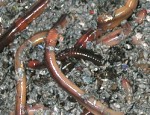 For years the night crawler has been the leading live bait choice among the majority of anglers. The night crawler is deadly and irresistible to most large game fish when used as live bait on a crawler harness, any type of hook/weight rig, tipped on jig or under a bobber set-up for walleye, largemouth and smallmouth bass, trout, catfish, and sturgeon. Using a small piece of a night crawler you can have fun catching perch, bluegill, rock bass and other Panfish as well. *Tip* To make a night crawler more visible and enticing to fish inject them with small amounts of air, this allows the bait to float off the bottom when using weighted bottom rig. Bait shops sell worm air injectors, a small bottle with a needle and a protective cap.
For years the night crawler has been the leading live bait choice among the majority of anglers. The night crawler is deadly and irresistible to most large game fish when used as live bait on a crawler harness, any type of hook/weight rig, tipped on jig or under a bobber set-up for walleye, largemouth and smallmouth bass, trout, catfish, and sturgeon. Using a small piece of a night crawler you can have fun catching perch, bluegill, rock bass and other Panfish as well. *Tip* To make a night crawler more visible and enticing to fish inject them with small amounts of air, this allows the bait to float off the bottom when using weighted bottom rig. Bait shops sell worm air injectors, a small bottle with a needle and a protective cap.
Night crawlers are easy to keep and sold at all bait shops, some gas stations and sporting goods section at discount stores. Many anglers prefer to collect their own bait by yanking night crawlers out of their holes in the backyard. If you’re night crawler hunting the best time is evening after a hard spring or summer rain, it can be as simple as picking them off the street, especially the ones that have low curbs with grass parkways, darker streets are more productive than well lit ones as they are light sensitive.
Searching in grass under leaves and rocks where the soil is moist use a flashlight and cover the lens with red cellophane, night crawlers for some reason can feel white light, shine a flashlight directly on a night crawler and they will slide very quickly back into their hole. Night crawler picking is fun on a warm summer evening after a rain, just bring a container and get plenty of bait for free.
Red Worms
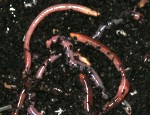
Red worms also known as leaf worms, garden worms and red wigglers. They are very popular live bait for game fish that prefer smaller worms, such as panfish, bluegill, perch and trout. Red worms are hardy and not as sensitive to temperature as the common night crawler. They are also very active when placed on a hook as they wiggle attracting and catching fish. Red worms are especially effective when it comes to bait stealers, small mouthed sunfish that nibble at the bait, to increase the catch thread a red worm on a hook and leave the hook point uncovered.
 *Tip* Most youngsters are taught how to fish by starting out with hook, weight, bobber and carton of red worms off of a dock or from shore. If your looking to set-up your child with rod and reel here’s a recommendation: Buy a quality 5 1/2 ft spin cast ( closed faced combo) light action spooled with 6lb test, this will be better and easier for kids than the short brightly colored fishing outfits that are available.
*Tip* Most youngsters are taught how to fish by starting out with hook, weight, bobber and carton of red worms off of a dock or from shore. If your looking to set-up your child with rod and reel here’s a recommendation: Buy a quality 5 1/2 ft spin cast ( closed faced combo) light action spooled with 6lb test, this will be better and easier for kids than the short brightly colored fishing outfits that are available.
For rigging purchase a package of size 8 aberdeen long shank hooks a pack of BB sized split shots and a few bobbers that attach to the line about the overall size of a quarter, the smaller bobber is intended to suspend your bait in the water and alert when to set the hook. Using a larger bobber the harder it will be to set the hook and detect a bite. To complete the set-up tie on the hook using a clinch knot above about 6-10 inches place a spilt shot or two then attach the bobber.
Worm Care & Storage

Night crawlers and red worms are stored refrigerated in bait shops as they require a dark and cooler environment to survive. When fishing with earthworms for the day they should always be kept in the shade and out of direct sunlight especially when it‘s very warm. Nothing smells worse than a container of sun baked worms. After your day on the water to keep your bait fresh either put them in a cooler with ice, place the container on top you don’t want to drown your bait in the cooler water or place the container in a refrigerator.
For keeping worms in a good condition for a extended period of time you should consider buying a portable worm carrier. Most containers made of a insulated material that will maintain a cool moist environment that worms enjoy. Some models can be dipped into water to aid in keeping them moist others have external ice pack holders for hot days.
To get at the worms easily many have two access doors that you can flip the container over when they burrow to the bottom, make sure the container has a snug fitting lockable doors. Another choice is what material to store them in. We recommend buying commercially made worm bedding available at most tackle shops. The cellulose organic based bedding makes temperature and moisture regulation easier. Many worm containers have kits with bedding included just follow the instructions on the package.
Fishing with Leeches
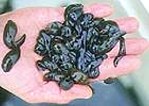
Leeches are the most plentiful of all the baits. They can be left in a container of water for a long time without food. Walleyes love leeches almost all year round and they are classified as universal bait for walleyes. Fish eat many types of leeches, but only the ribbon leech is widely used as bait. The color of a ribbon leeches varies from pure black to light brown and some have a brown or olive background with many black spots.
Leeches are easy to keep alive. They are not as sensitive to temperature changes as minnows, and they require relatively little oxygen. Leeches can be kept alive until fall, even without food, but they should be allowed to clean themselves. Anglers can keep the bait “cleaner” by rinsing the leeches on a daily basis and storing them in fresh, clean water in a cool place.
The summer is the best time to fish with leeches; by mid-summer most of the adult leeches have deposited cocoons and die off. Also, in the summer time the leech will wiggle more below a bobber than a worm. When drifting or trolling, anglers will catch suspended walleyes on floating jigheads and slip sinker rigs.